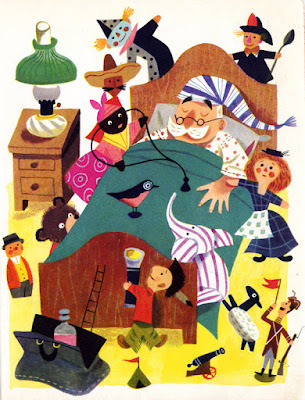Out of Asia, many thousands of years ago, came Wanderers. Some historians think they were the first people to set foot on our western hemisphere. These Wanderers had walked, step by step, onto our part of the earth while hunting and gathering food. They probably never even knew they had moved from one continent to another as they made their way across a land bridge, a narrow strip of land between Siberia and what is now Russia, and the state of Alaska.
Historians do not know exactly how long ago the Wanderers might have crossed the land bridge. Some of them say 35,000 years ago. ...
Those Wanderers who made their way to California were very lucky, indeed. California was a land with good weather most of the year and was filled with plenty of plant and animal foods for them to eat.
Not only did the California tribes speak different languages, but their members also differed in size. Some tribes were very tall, almost six feet tall. The shortest people came from the Yuki tribe which had territory in what is now Mendocino County. They measured only about 5'2" tall. All Native Americans, regardless of size, had strong, straight black hair and dark brown eyes.
What may have been once an effective means to portray how artifacts were used in context of early Native American civilization has become inexpedient, often evoking pejorative connotations, and sometimes fostering perceptions of Indians as “frozen in time,” said Amy Harris, director of the University of Michigan’s Exhibit Museum of Natural History.
In early January, 14 dioramas at the museum will be taken from public viewing and placed in storage. Until then, Harris said the dioramas are a catalyst for a broader discussion about the role of museums, and the proper portrayal of Native Americans, the only people relegated to be “presented” in natural history museums.
“We were concerned that we were leaving the impression that Native Americans are extinct, just like the dinosaurs on the second floor,” said Harris, who, since 2000 has met regularly with a range of constituents, including U-M faculty, students and Native Americans around the state. The goal was to gauge the effectiveness of exhibits. Harris soon found out the dioramas were offensive and perpetuated negative attitudes.
I urge you to revisit that justification. Who is 'they' in that way of thinking? That justification suggests such things no longer happen. But the thing is, books with that sort of thing come out, today, in 2023. And I see the Boulé books on library lists of recommended books, today! If you're using them or recommending them, stop! They're completely unacceptable. The paragraphs from the University of Michigan's director can help you think more critically about books -- old or new -- that have a land bridge theory or frozen-in-the past depictions of Native people.


























